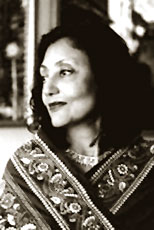 The remarkable non-fiction by Bharati Mukherjee, `The Sorrow and the Terror: The Haunting Legacy of the Air Indian Tragedy` is a critical examination of racism and horror. The 1985 airline crash is aptly depicted in the novel while befitting the title.
The remarkable non-fiction by Bharati Mukherjee, `The Sorrow and the Terror: The Haunting Legacy of the Air Indian Tragedy` is a critical examination of racism and horror. The 1985 airline crash is aptly depicted in the novel while befitting the title.
Bharati Mukherjee is an author of Indian origin now with an American citizenship at her hand she teaches English in a university in California-Berkeley. After moving back from Canada to the United States, she wrote about her personal experiences. In her writings some of the biased Canadian view towards immigrants are jotted down. Again another novel of her creation continues to reflect on her focus on immigrant Indian women and their mistreatment. It narrates how a divorced Indian woman studying in the States and her experiences with interracial relationships. Mukherjee`s views on Indian men are prominent in this novel as she said about them being too preoccupied to truly care for their wives and children. In her novels the sufferings of women in different scenario has come up in different way. In one of her novels the protagonist being suppressed by her arrogant husband one day revolts back and murders him resulting committing suicide of her own. Again in another one the author further endeavor to tell similar stories of immigrants and women. She is such a writer whose voice tells the tales of her own experiences to demonstrate the changing shape of American society.
Synopsis:
`The Sorrow and the Terror: The Haunting Legacy of the Air Indian Tragedy`, is one of the academic works of Indian politics and society by Bharati Mukherjee as well as her husband Clark Blaise. This piece of work is actually an examination of the horror and latent racism exposed by the 1985 airline crash that killed hundreds of Canadian citizens, most of whom were of Indian descent. Today Mukherjee teaches English at the University of California at Berkeley where she remains a vocal proponent of the rights of women and immigrants. About the writing plot of the story the author says in her words, "This non-fiction book is about the terrorist bombing of an Air India jet that took off from Toronto on its way to Bombay with 329 people on board, ninety percent of whom were Canadians of Indian origin. The bad guys were Canadians, but Sikh, militant Khalistanis in politics. It was the bloodiest terrorist incident until WTC. We interviewed all the terrorist cells, including an interview with the guy who financed the bombing and has just this November finally been arrested. We talked to the bereaved also. The book was a nonfiction bestseller in Canada. We were under death threat for two years". From this quote the readers can get an idea of the author`s courageous side because of which Bharati Mukherjee is being able to make a position for her in the American and world literature as well.
The Sorrow and the Terror: The Haunting Legacy of the Air India Tragedy is a work of non-fiction written by Bharati Mukherjee and co- written by her husband Clark Blaise. It was first published by Viking Canadain in1987.
`The Sorrow and the Terror` is a super creation of which is named as non-fiction. This brings the reality behind the air crash that happened on 23rd June 1985. That day the Air India Flight 182, with three hundred and twenty-nine passengers bound for India, was down off Dunmanus Bay, Ireland. Blaise and Mukherjee write from several perspectives in a tremendous way e.g. as immigrants, as Canadians, and as advocates for the victims` families. At times they are angry at the apparent unconcern of Canadian officials while at times they are grateful, especially for the official and unofficial outpouring of concern and help from the Irish. As a whole this is a masterpiece of Bharati Mukherjee, which still raises a lot of question to the society.













